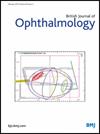Global burdens and causes of blindness and vision loss in children and adolescents from 1990 to 2021 and forecast for the next decade.
IF 3.5
2区 医学
Q1 OPHTHALMOLOGY
引用次数: 0
Abstract
BACKGROUND To estimate the global, regional and national burdens of blindness and vision loss among children and adolescents from 1990 to 2021, categorised by age, severity and cause, and to project the burdens through 2030. METHODS Based on the Global Burden of Diseases, Injuries and Risk Factors Study 2021, the burden of blindness and vision loss was evaluated by case numbers, rates per 100 000 population and average annual percentage changes (AAPCs) in prevalence and years lived with disability (YLD) rates. The burden of trends from 1990 to 2021 was analysed using a joinpoint regression model, and the Bayesian age-period-cohort (BAPC) model projected the disease burden through 2030. RESULTS Globally, there was no significant change in the prevalence rate of blindness and vision loss from 1990 to 2021, but the YLD rate significantly decreased (AAPC -0.17). The prevalence and YLD rates declined for refraction disorders and other vision loss from 1990 to 2021 but increased for near vision loss. The prevalence and YLD rates of refractive disorders show the most significant increase in East Asia. The BAPC model forecasts a rise in global blindness and vision loss prevalence and the YLD from 2021 to 2030 (1.63% and 0.03%, respectively), although refraction disorders and other vision loss are expected to decline. CONCLUSIONS Over the past three decades, global efforts have reduced the burden of blindness and vision loss among children and adolescents. Despite the overall decrease in refraction disorders, East Asia remains a challenge.1990年至2021年儿童和青少年失明和视力丧失的全球负担和原因以及未来十年的预测。
根据年龄、严重程度和原因,估计1990年至2021年全球、区域和国家儿童和青少年失明和视力丧失的负担,并对到2030年的负担进行预测。方法基于《2021年全球疾病、伤害和危险因素负担研究》,通过病例数、每10万人的发病率、患病率和残疾生活年数的平均年变化百分比(AAPCs)来评估失明和视力丧失的负担。使用联结点回归模型分析了1990年至2021年的趋势负担,贝叶斯年龄-时期-队列(BAPC)模型预测了到2030年的疾病负担。结果在全球范围内,1990年至2021年,失明和视力丧失的患病率无显著变化,但YLD率显著下降(AAPC -0.17)。从1990年到2021年,屈光障碍和其他视力丧失的患病率和YLD率有所下降,但近视力丧失的患病率和YLD率有所上升。屈光性疾病的患病率和YLD率在东亚地区增长最为显著。BAPC模型预测,从2021年到2030年,全球失明和视力丧失患病率以及YLD将上升(分别为1.63%和0.03%),尽管屈光障碍和其他视力丧失预计将下降。结论在过去三十年中,全球努力减轻了儿童和青少年失明和视力丧失的负担。尽管屈光障碍总体上有所减少,但东亚仍然是一个挑战。
本文章由计算机程序翻译,如有差异,请以英文原文为准。
求助全文
约1分钟内获得全文
求助全文
来源期刊
CiteScore
10.30
自引率
2.40%
发文量
213
审稿时长
3-6 weeks
期刊介绍:
The British Journal of Ophthalmology (BJO) is an international peer-reviewed journal for ophthalmologists and visual science specialists. BJO publishes clinical investigations, clinical observations, and clinically relevant laboratory investigations related to ophthalmology. It also provides major reviews and also publishes manuscripts covering regional issues in a global context.

 求助内容:
求助内容: 应助结果提醒方式:
应助结果提醒方式:


